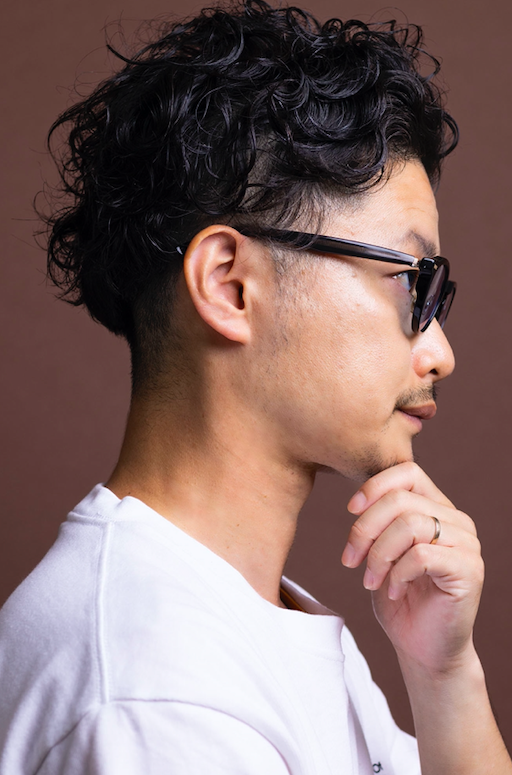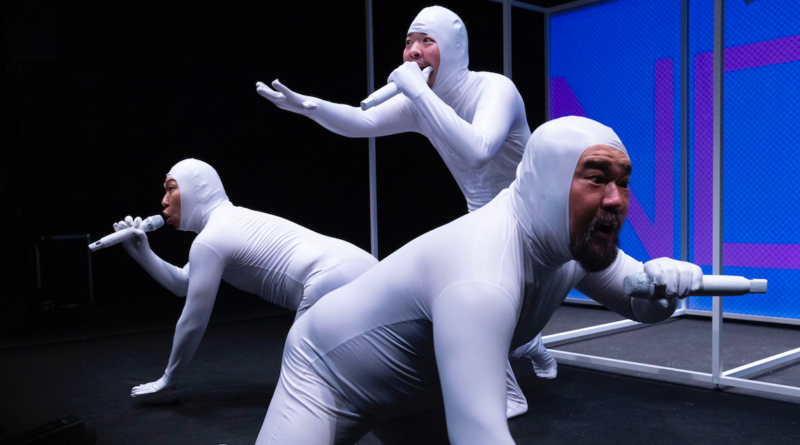INTERVIEW: Yu Murai continues his Shakespearean journey with ‘Hamlet |Toilet’
Photo: Hamlet | Toilet features, from left, Takuro Takasaki, Yuki Matsuo and G.K. Masayuki, all from from Kaimaku Pennant Race. Photo courtesy of Takashi Ikemura / Provided by Seven 17 PR with permission.
Japan Society in Midtown Manhattan is preparing to celebrate the return of the Under the Radar festival by presenting the American premiere of Yu Murai’s Hamlet | Toilet, which runs Jan. 10-13 and stars performers from Kaimaku Pennant Race. This is not the first time Murai or KPR have explored the work of William Shakespeare. Their previous efforts have dissected Macbeth (Ashita no Ma-Joe: Rocky Macbeth) and Romeo and Juliet (Romeo and Toilet).
As the title suggests, this is not a typical interpretation of the Bard’s Hamlet. Press notes indicate this production will be nonsensical, and the actors will be decked out in KPR’s unique full-body unisuits. Audience members should expect the unexpected. After all, Romeo and Toilet was performed on a set made to look like an enormous toilet, so anything can happen.
Murai is the writer and director of this Hamlet, and he founded KPR, a company dedicated to taking classic texts and reinterpreting them with physicality and over-the-top humor, according to his official biography. Recently Hollywood Soapbox exchanged emails with Murai, working through a translator. Questions and answers have been slightly edited for style.
How closely does Hamlet | Toilet stick to the original play by William Shakespeare? Is this a radical reinterpretation?
As for the story structure and themes, we created the piece faithfully to the original work. We then reinterpreted the setting to the toilet. Because Hamlet’s suffering is a solitary struggle, therefore, I thought of a place where one can shed one’s false self and face one’s loneliness without worrying about the eyes of others, in other words, the smallest unit of private space in the modern age, which is the private room of the toilet. It is truly a “struggle against the changes in the body that are now before us,” and there is no work more simple, confronting all times and environments, and yet overwhelmingly solitary. Everyone can easily imagine it close at hand, but everyone can only realize it from the memory of their own unique body. Therefore, I thought that what I would put on stage should not be the greatest common denominator, but a story of solitary bodies emanating from the images of each individual, including the audience, and their aggregate. Once again, my own solitary body is the starting point. This may be the only answer to the vague anguish of this society, which is caused by the accumulation of such communication, as we have become accustomed to not only facing our own anguish but also indirect communication and quoting only the knowledge of someone else that exists in our monitors.
By adding humor and physicality to these classic plays, what are you hoping to achieve? Do you feel these reinterpretations allow audience members the chance to go deeper with these well-known characters and stories?
First of all, in Japan, when people hear the word “classic,” they often dismiss them as “boring” due to the perception that they are “old” or “serious,” so we want to make the title catchy, chuckle-worthy and engaging for the audience. Humor must be sensed at the “pause” in conversation, the “pause” in movement and the “pause” in breathing. These “pauses” give the audience a great opportunity to expand their imagination.
Regarding the physicality of the work, one of my motivations for creating theater is my desire to encounter a version of myself that I have not yet seen. To do so, it is necessary to know myself and for others to know me. In other words, in order to encounter the unknown parts of myself, it is necessary to encounter many unknown others. Therefore, the KPR (Kaimaku Pennant Race), which I preside over, has intentionally targeted a global audience.
While I am aware of the fact that my physicality is highly regarded, I am not so conscious of pursuing physicality, since my main purpose is to work with the above-mentioned objectives in the first place. We believe that our “physicality” is pushed out by the evaluations of those around us, as we present a moment that transcends the language barrier as a result of the text composition based on the interpretation of the play, the direction of the staff work and the performance of the actors that transcends the direction, all of which are combined.
What’s it like collaborating with the performers from Kaimaku Pennant Race?
Takuro Takasaki and I have known each other since before KPR was formed, and we started our theatrical activities together from the theater company Yamanote Jijosha, which is known for its participation in the Sibiu International Theater Festival.
G.K. Masayuki and Yuki Matsuo have been instructed not only by me but also by Takuro. Both of us have the above-mentioned physical method that emphasizes physical balance inherited from the Yamanote Jijosha Theater Company and have shared it with G.K. and Yuki. With this physical method, they can easily understand my intention of direction not to interrupt the audience’s dramatic experience when quickly developing from one scene to another.
What’s the significance of the white unisuits that the performers wear during the performance?
When we remade Romeo and Toilet in Japan in 2013, which we presented in New York in 2009, we had the performers wear full-body tights to represent “Romeo’s sperm delivered to Juliet.” Next, for “Rocky Macbeth,” presented in New York in 2019, we continued to use full-body tights as a costume to represent “a white mat in a boxing ring” and, this time, to represent a white toilet bowl in a bathroom. Since all of those elements are commonly “white” in any culture, regardless of nationality or race, we believe that they can be conveyed globally as theatrical expressions.
Many of your theater company’s shows pull from today’s cultural influences. Are you a big consumer of today’s culture?
Manga has greatly influenced my life choices. For example, I started playing soccer after reading Captain Tsubasa, baseball after reading Dokaben, boxing after reading Ganbare Genki, etc. I am greatly influenced by them.
When did you realize you wanted to be a theater-artist?
When I was 24 years old, working as a public servant in Tokyo, with a guaranteed future to some extent and realizing that I could not hope for any major changes in the future, I happened to be invited by a friend to participate in a theater workshop. Believing in the excitement of encountering a part of myself that I did not know, I decided to follow this path.
By John Soltes / Publisher / John@HollywoodSoapbox.com
Hamlet | Toilet, written and directed by Yu Murai and performed by Kaimaku Pennant Race, plays Jan. 10-13 at the Japan Society in Midtown Manhattan as part of the Under the Radar festival. Click here for more information and tickets.


